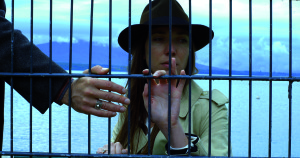
Most of the suspense in Christopher Nolan’s Dunkirk comes not from its many action set-pieces but from wondering just how the director will pull off his structural conceit. The film follows three sets of characters involved in the English evacuation of Dunkirk’s beaches in 1940 and while the three scenarios are intercut together, each unfolds over a different length of time. Over the course of a week, a host of brunette British boy soldiers, including those played by Fionn Whitehead and Harry Styles, try desperately to escape the beach surrounded by unseen German forces. At sea, a civilian (Mark Rylance) looking to take part in the rescue effort sails from England in a day with two young boys in tow. And for an hour, Royal Air Force pilots (Tom Hardy and Jack Lowden) provide air support, staving off enemy fighters to ensure safe passage for the soldiers below.
It’s an admirable structural experiment, but it is also dramatically counterintuitive as the cuts between scenarios are often jarring and nearly always lessen any tension built by the last scene. This is of particular issue when cutting from the action on the beach itself, a series of doomed escape attempts that serve as the film’s major set-pieces, to the sky, where an endless string of repetitive and inelegantly composed dogfights plays out. With the action on land possessing more incident than the other two sections combined, Dunkirk is at its dullest when the air and sea narratives begin to converge. As the action in the sky takes place in the last hour of the boat’s day, the two narratives come together in a plodding game of follow the leader. When a plane falls from the sky it does so with the assurance that, in due time, the boat will come to its rescue.
Nolan is so committed to this triptych that, even when all three threads finally do converge, he can’t help but shift between spaces and times, filling in the blanks of an ellipsis. It’s unfortunate that this flashback–I mean, that’s really all it is–should be the film’s most harrowing sequence, as the constant leaps in time almost muddy it into indistinct chaos. This devotion to the conceit seems hellbent on leaving nothing to the imagination while simultaneously blurring everything together in a confusing mess. Never have I wished a movie were more traditional, as its moment-to-moment strengths are plenty.
From his earliest scenes, newcomer Fionn Whitehead proves wonderfully adept at moving through space wordlessly, whether it be in his initial escape from town to the beach or in running with a stretcher, Damien Bonnard holding up the other end, trying to catch a ship off the beach. The latter is a thrilling, suspenseful bit that includes an ingenious bit of hiding and concludes with Whitehead meeting his counterpart for the rest of the film, Harry Styles, who also makes good in his film debut. In the film’s best scene, the pair find themselves at odds when trapped with a group of other soldiers under fire from the Germans, Styles’ hopeless suspicion providing a rough, frustrated foil to Whitehead’s timidity. That the two exude a fresh energy that carries many of their scenes makes it a chore to watch great known quantities like Rylance and Kenneth Branagh reduced to spouting platitudes and providing exposition. And that they so capably move from spectacular set-piece to desolate beach and back serves to further highlight how jarring and unwelcome the film’s structure can be.
Although this structure rarely strengthens the narrative, it’s not without thematic ends. In splitting the escape from Dunkirk across three sections, Nolan might seek to tell a more personal story, one that considers individual perspectives on the nature of war. But when most those perspectives are those of trite war movie archetypes, it’s a shallow attempt at theme regardless of how it’s told. Worse, in the face of the film’s treatment of its casualties, this reclamation of personal narrative is dishonest. The day after a U-Boat torpedoes a British warship, the bodies of the fallen come in with the tide, brushing up against the legs of soldiers on the beach. The corpses float on their stomachs, their faces down into the water, never to be seen. Repeatedly, the large swaths of soldiers who die in explosions the film’s heroes survive are, and remain, completely anonymous. Once is a dying soldier a man we have come to know and never is he a character with any sort of distinct personality. Death is so often brushed aside in Dunkirk that the film’s apparent personal approach is preposterous.
—
Directed by Christopher Nolan; written by Christopher Nolan; starring Fionn Whitehead, Tom Glynn-Carney, Jack Lowden, Harry Styles, Aneurin Barnard, James D’Arcy, Barry Keoghan, Kenneth Branagh, Cillian Murphy, Mark Rylance, and Tom Hardy; 106 minutes.



 Derek
Derek
 Isabelle
Isabelle